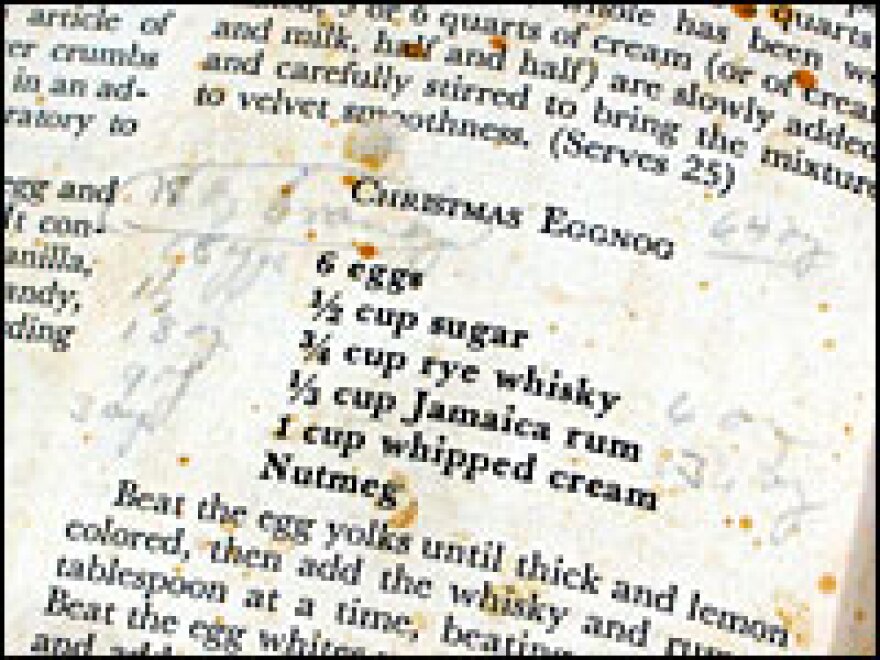
One of my earliest memories is of standing atop a stool beside my father in the kitchen on the day after Thanksgiving as he made eggnog. I must have been 6 or 7 at the time, because I remember the silvery bowl was almost as big as I was.
I recall that he added whiskey to the bowl in a slow stream, as carefully as a chef making mayonnaise, the electric mixer going full speed, beating, whining and rattling against the sides of the bowl. He was, and is, a gentle man, but he was also big and expansive, and that was the most delicate and patient operation I have ever seen him perform.
The whiskey entered the maelstrom almost drop by drop. He'd learned from past years that working too quickly, too brashly, produced scrambled eggs instead of the smooth and unctuous base he'd need a month from that day when he added the cream and served the nog to guests. And there were the inevitable splatters that over the years had accumulated on the open pages of the cookbook containing the recipe.
Almost every Thanksgiving for 50 years, my father has made eggnog, which he then ages until Christmas — a once-common practice that mellows the mixture to the point where the alcohol is almost impossible to detect.
This liquid thread linking Thanksgiving and Christmas is a family tradition, a footnote in the long history of eggnog.
The origin of eggnog, as with any recipe more than 100 years old, is more theory than fact. However, early recipes were often made with ale, which was often served in a "noggin" (a small cup) and likely was the source of the "nog" or "nogg" portion of the name. The "egg" part is self-evident. We also know that, made with brandy or wine, it was an expensive drink popular with the English aristocracy.
Jerry Thomas' Bartenders Guide or How to Mix Drinks (first published in 1862) included this recipe:
Egg Nogg
(Use large bar glass.)
Take 1 large teaspoonful of powdered white sugar.
1 fresh egg.
1/2 wine glass of brandy.
1/2 wine glass of Santa Cruz rum.
A little shaved ice.
Fill the glass with rich milk and shake up the ingredients until they are thoroughly mixed. Pour the mixture into a goblet — excluding the ice — and grate a little nutmeg on top. This may be made by using a wine glass of either of the above liquors, instead of both combined.
Every well-ordered bar should have a tin egg-nogg "shaker," which is a great aid in mixing this beverage.
Another version in the same book calls for 20 eggs and 2 1/2 quarts of "fine old brandy."
Eggnog likely came to the United States from England with aristocratic immigrants. Isaac Weld, an 18th-century Irishman who wrote about his travels in America, noted: "The American travelers, before they pursued their journey, took a draught each, according to custom, of egg-nog, a mixture composed of new milk, eggs, rum and sugar, beat up together." Brandy was indeed a precious commodity in the New World, so rum became the most common alcohol in the North, while bourbon became typical in the South.
My father's original recipe came from his favorite cookbook, The Wise Encyclopedia of Cookery that was published in 1951. The book was reprinted about 30 years ago, and I bought a copy as a Christmas gift for my father. In return, I asked for his old, battered, green, cloth-bound edition for my library. I did want the old book as a connection with my father; but more, I wanted the pencil notations on the eggnog recipe that detailed his changes to the ingredients.
Since Thanksgiving was a week early this year, there is still time to make a batch, stick it in the back of a closet and — come Christmas — pull it out and add the cream.
For the many Christmases that I've since spent away from my parents, I've often turned to my father's old volume, now bound in duct tape, to make a batch of nog myself. As I hoped back when I swapped a new book for his old one, I feel his presence beside me when I make it, and again when I raise a noggin to him.
Copyright 2023 NPR. To see more, visit https://www.npr.org. 9(MDM3NjYwMjA5MDE1MjA1MzQ1NDk1N2ZmZQ004))

